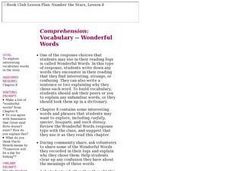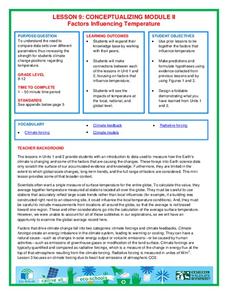Montana State University
What's the Weather?
How many jackets do you need to stay warm and climb Mount Everest? An informatie resource covers the topic of Mount Everest, the resource helps young scientists discover the difference between climate and weather. Activities include...
Curated OER
Comprehension: Vocabulary - Wonderful Words
While reading Chapter 8 of Number the Stars, learners write down any words they encounter in their reading that they find interesting, strange, or confusing. They record why they chose each word, and after completing the reading...
National Wildlife Federation
Conceptualizing Module II - Putting It All Together
"Creativity is just connecting things." - Steve Jobs. After weeks of researching climate change, the ninth lesson in a series of 21 combines the data and analysis to address essential questions. It covers natural phenomenon, human...
Curated OER
Flying the Friendly Skies
Students discover the power of wind by flying a glider. In this weather lesson, students describe their thoughts on wind and practice using weather related vocabulary. Students construct model gliders in class and attempt to fly them...
Curated OER
Buildings Have Lives, Too: Disasters and Their Effect on People
Students research natural disasters and their lasting effect on both people and the environment. In this environmental science lesson, students complete a group project on a natural disaster of their choosing. Students examine multiple...
Curated OER
What Are the Layers of the Rain Forest?
Young scholars investigate the different levels of the rain forest by comparing it to an apartment. In this ecology lesson, students practice using forest related vocabulary words and complete a vocabulary data sheet. Young scholars...
National Wildlife Federation
Get Your Techno On
Desert regions are hotter for multiple reasons; the lack of vegetation causes the sun's heat to go straight into the surface and the lack of moisture means none of the heat is being transferred into evaporation. This concept, and other...
Montana State University
Meet Mount Everest
Learning about one landform might seem boring to some, but using the resource provided practically guarantees scholar interest. The second in a sequential series of eight covering the topic of Mount Everest includes activities such as a...
Curated OER
What is Climate?
Students explore the differences between climate and weather. In this introductory instructional activity of a climate unit, students discuss the vocabulary and concepts associated with weather and climate. They build their information...
Curated OER
Writing
Students write poems and a narrative story. In this writing lesson, students read stories and poems written by other students and read examples of haiku's and diamonte's. Students write an acrostic poem and a diamonte poem. Students...
Curated OER
Poetry in Motion
Students expand their understanding and appreciation for poetry. In this poetry unit lesson, students complete 5 unit sections of multiple day activities to learn about poetry and its devices or forms.
Curated OER
Lightning It's Shocking, It's Frightening, It's Lightning!
Third graders decide what they want to explore lightning, how to go about finding the answers, and deciding what skills they need to further study some of their questions.
Curated OER
A Thoreau Look at Our Environment
Sixth graders write journal entries o school site at least once during each season, including sketched and written observations of present environment. They can use sample topographical maps and student's own maps. Students can use...














